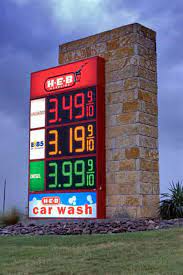Gas station signs play a crucial role in guiding drivers towards fueling stations and promoting their respective brands. These towering structures, strategically placed along highways and busy streets, not only indicate the availability of gas but also provide essential information such as current fuel prices, amenities, and sometimes even quirky messages to catch the attention of passing motorists. Beyond their functional nature, gas station signs have evolved over the years to become powerful marketing tools that strive to capture the fleeting attention of drivers and influence their choice of gas station.
With vibrant colors, bold typography, and eye-catching designs, gas station signs aim to engage customers and leave a lasting impression in a highly competitive market. This article explores the history and significance of gas station signs, examining their evolution from simple illuminated signs to technologically advanced digital displays. Furthermore, it delves into the psychology behind effective sign design, highlighting the importance of legibility, positioning, and visual appeal in attracting potential customers. Let’s delve into the fascinating world of gas station signs and discover how these roadside beacons have become integral elements in the modern marketing landscape.
The Evolution of Gas Station Signs
Gas station signs have come a long way from their humble beginnings as simple illuminated signs. The early gas stations in the late 19th century used basic signs to indicate the presence of fuel, often consisting of just a few letters or an image of a gas pump. However, as the automobile industry grew and more gas stations started popping up, competition became fierce, and gas station owners realized the need for more eye-catching signs to attract customers.
As technology advanced, so did gas station signs. In the mid-20th century, neon signs became popular, adding a vibrant and colorful display to gas station exteriors. These signs not only served as beacons to guide drivers but also became iconic symbols of the time. Today, gas station signs have transitioned to highly sophisticated digital displays, capable of showcasing dynamic content and real-time information. These modern signs incorporate LED technology and advanced graphics to capture the attention of passing motorists.
This evolution of gas station signs reflects the changing landscape of marketing and advertising. Gas station owners understand that capturing the attention of drivers is essential for their business. Unique and visually appealing signs have become integral to their branding strategies, helping them stand out among competitors. To explore some of these captivating gas station signs yourself, you can visit websites like gas station signs, which offer a vast collection of vintage and modern signs that showcase the history and artistry behind this iconic form of advertising.
In conclusion, gas station signs have undergone a remarkable transformation over the years, evolving from simple illuminated signs to technologically advanced digital displays. These signs have become essential marketing tools in a highly competitive industry, aiming to capture the attention of drivers and influence their choice of gas station. With vibrant colors, bold typography, and eye-catching designs, gas station signs engage customers and leave a lasting impression. The history and significance of gas station signs demonstrate their role as integral elements in the modern marketing landscape. As technology continues to advance, we can expect gas station signs to further innovate and adapt to attract drivers and promote their respective brands.
